THE FLY FISHING CHRONICLES OF YELLOWSTONE NATIONAL PARK – PART6
| Sysadmin Note |
|---|
| Part 5 can be found here |
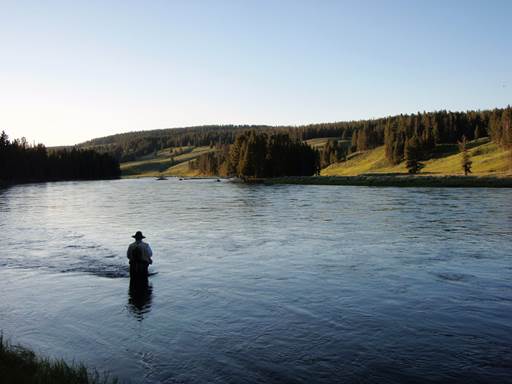
The most majestic river in Yellowstone National Park is the Yellowstone River and it is by far the complex and challenging river in the Park and because of its length and diversity of habitat it is one of most interesting rivers that the angler will ever encounter. Each major section of the river differs somewhat from the other sections; therefore I will break it down into five sections. First, we will discuss the section of the river from the outlet of the lake to falls of the Grand Canyon of the Yellowstone. Besides discussing the section that I have chosen for this column I will regal you with some historical information on how the river obtained its famous name. I will be giving you a brief overview of the fishery that we can find in this section of the river.
The Yellowstone River has had many names. The Crow Indians referred to it as the Elk River, the Mandan's called it Stone Creek, the early French trappers referred to it as Roche Jaune or Yellow Rock River; however the name Yellowstone was commonly known and accepted as early as 1780. The Lewis & Clark Expedition recorded the name as the Yellow Stone River, the river was explored by William Clark in 1806 and the Clark's Fork of the Yellowstone bears his name. However Captain Clark never traveled into Paradise Valley or near what was to become the first National Park. That expedition had to wait until 1870.
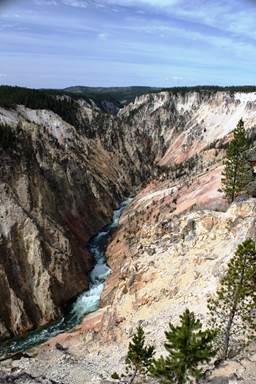
The section of water between the outlet of the lake and falls of the Grand Canyon of the Yellowstone is much like the Firehole River with geysers and hot springs entering the river in various places. This added richness makes this section a strange mix of spring creek like and freestone water and the richness of the hatches is legendary.
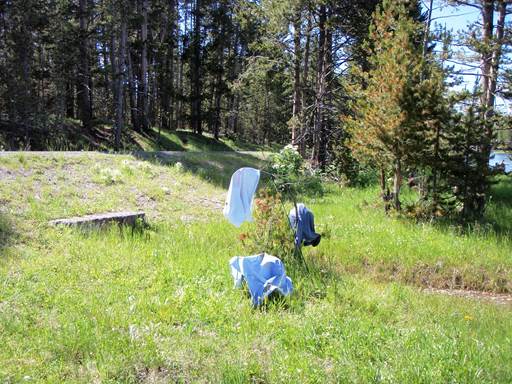
But make no mistake, the Yellowstone is this section is big water and the currents are swift and all it takes is a careless moment or a misstep and you can be swimming with the fish so wade carefully!
The fishing season for this section of the river doesn't begin until July 15th due to the cutthroat trout spawning season and it closes on the first Sunday in November as does all the fishing in the Park.
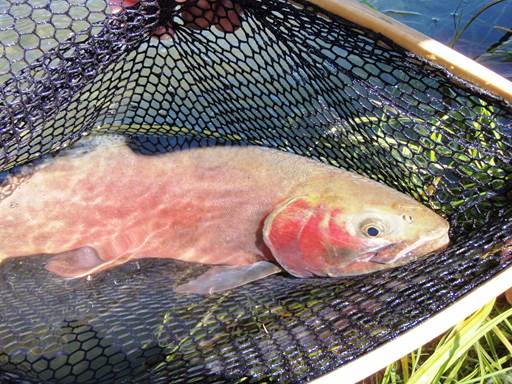
The fish that are found in the waters of this section are few in numbers the main attraction is the Yellowstone Cutthroat Trout, Oncoryhynuchus clarki bouvieri, also referred to as Salmo clarki bouvieri, and is the only trout found in these waters. The cutthroat trout are now considered to be the native fish of the Yellowstone River, however in geological time the cutthroat is a new comer as these trout we originally only found west of the continental divide. Sometime around six to seven thousand year ago they made their way into the east side of the divide and found a ready home in the waters of the Yellowstone River and its sister streams. When Captain Lewis traveled the bank of the Yellowstone the cutthroat trout was the only trout in the water.
Cutthroat trout live up to eleven years and are late spring and early summer spawners, forming pairs and digging redds in smooth even gravel as do other trout. They begin their spawning run normally after the river has peaked from the annual runoff and begins to drop. Though cutthroat trout are known as tributary spawners and in the case of the Upper Yellowstone it is a giant spawning tributary for Yellowstone Lake. Besides the thousands of trout that drop down from the lake to spawn there also is a resident population cutthroat trout in the river that never travels to and from the lake.
Over the year's cutthroat have been praised and condemned depending on when the anglers visited the river. The anglers who arrived at the time that the cutthroat trout are coming off the spawning beds will crow over the number of stupid cut's they were able to catch. Then in the next breath demean the fighting ability of the cutthroat claiming that they offered no fight and just came right in to the net.
However if you think about it you will understand, the trout are coming off the spawning beds and during the spawning process they use up a lot of energy and stored body weight, once the spawning is over they begin to feed to regain their strength and begin the process of growing for the season. Of course they will be easy to catch and often times they can be less than fussy over what they eat! Now for those anglers who arrive to fish the river after August 10th find that these same trout which would eat anything a month ago now can be very fussy and in fact can be somewhat frustrating, this selective behavior continues on into September and October.
Once the spawning process is completed and the trout begin to regain their strength they also begin move back to the lake in slow easy stages, and during September and October you have to know where to look for the fish. It becomes much like fishing in New Zealand where you are searching for the trout and once you find them you must stalk them and present the proper imitations in the proper manner.
This is a river where the power of observation is one of the most important skills that the angler can have, and those who are in a rush often find the Yellowstone not to their liking.
Now let briefly talk about the lake trout, in 1994 the lake trout were officially recognized by the Park officials as being in Yellowstone Lake. That set off a huge outcry and lots of finger pointing about how they got there and how they were going to destroy all of the cutthroat trout in Yellowstone Lake.
I could write several pages on what I think of the views of the Park Service and the money that is being spent to remove the lake trout from Yellowstone Lake, however I will limit my comments to a couple of questions that I am most often asked. Are the lake trout the villains that they are made out to be and are they the prime reason for the decline of the cutthroat populations in Yellowstone Lake and the Upper Yellowstone River?
I believe that the lake trout were place in Yellowstone Lake back in to the 1920's when other lakes in the Park were stocked with the lake trout which means that they have been there for a long time. They will eat young cutthroats but they will also eat the long-nosed suckers, long-nose dace, the redside shiner and the lake chub and their own unwary young.
Lake trout do have an impact on the cutthroat, but they are not responsible for the population crash that happened a few years ago. In cases like this there is seldom a simple answer. I believe that the advent of whirling disease in some of the tributary streams to the lake has had a much greater impact than the lake trout. Also there is the fact of the increasing population of pelicans on Yellowstone Lake, and furthermore there are many species of wildlife that feed on the cutthroat trout, yet we as a people are always looking for the simple answer that points the finger at a villain.
There is one fact of nature that never changes and that fact is that nothing and I mean nothing in nature ever remains the same. Nature is always in a constant state of change, some of the changes take a long time to become apparent, others are quicker, even though they are some in the scientific community who will not accept any change that they can't document, yet most of their studies are done in the lab and seldom do they spend long hours on the water studying the trout in their natural habitat. I could list many examples of this behavior, however I am sure you would find this discourse boring and off the subject of the fly fishing.
There are a few other species of fish found in the Upper Yellowstone and though most anglers would not find them exciting they are of important to the cutthroat trout as forage fish.
The first of these is the long-nosed sucker [Catostomus catostomus]. This species is a late spring or early summer spawner and can reach 5 pounds in weight, and the newly hatched fry and young suckers are prey upon by the cutthroat trout. Next is the long-nose dace [Rhinichthys cataractae]. These minnows can reach six inches in length and they spawn in shallow riffles during the early summer or when the water temperatures reach 53 degrees. Finally there is the redside shiner [Richardsonius balteatus]. This minnow also spawns in the early summer and tends to be a school fish and they are normally only found from the big bend water and upstream towards Fishing Bridge. Again the cutthroat trout will feed on the fry and on the minnows that can attain a length of seven inches. There are no sculpins in the river above the falls at the head of the canyon.
In every disaster there can be a bright spot and one of the bonus's of the cutthroat population crash is that the Upper Yellowstone River is now seldom crowded. During the past, before the population crash, certain areas of the upper river could be somewhat crowded. What was then called Buffalo Ford, and now renamed as Nez Perce Crossing, could be alive with anglers. But once the news got out that the population had crashed anglers turned to other waters.
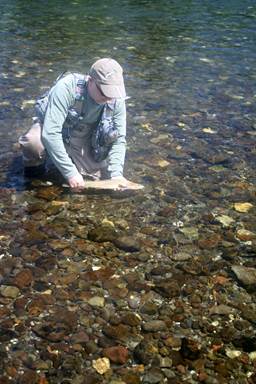
This is fine with me as I continued to fish the fabled waters of the Upper Yellowstone and soon noticed that the number of fish were down the size of the cutthroat trout were increasing. Today it is not unheard of to catch a 22 to 25 inch cutthroat trout, and that my friends is a great trophy by any standard.
So the next time you visit the Park set some time aside to explore the water of the upper river, consult the hatch chart and be observant and you should be well rewarded for your efforts.
Enjoy & Good Fishin
| Sysadmin Note |
|---|
| Part 7 can be found here |
